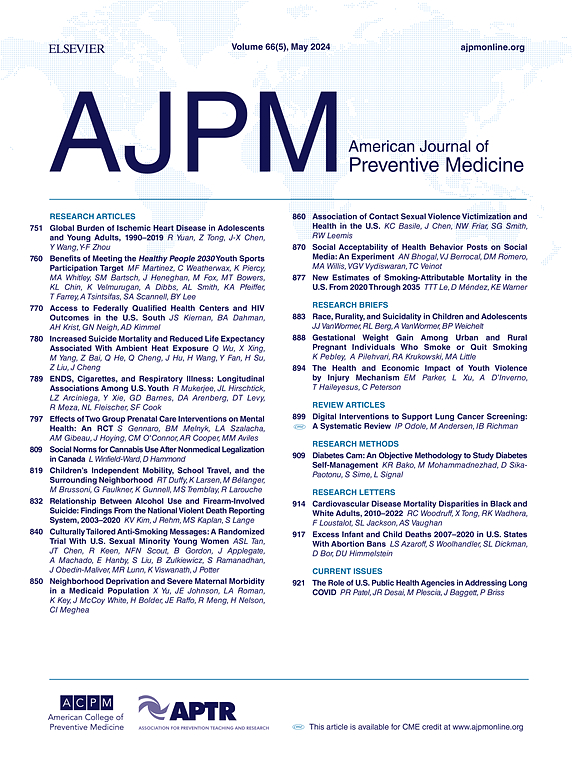Sexual Minority Identity and Physical Illnesses: Role of Life-Course Victimization and Gender Differences
IF 4.3
2区 医学
Q1 MEDICINE, GENERAL & INTERNAL
引用次数: 0
Abstract
Introduction
Sexual minority individuals experience higher rates of victimization and chronic physical health conditions. There are also known differences by gender in both victimization rates and victimization-linked chronic physical health conditions. However, few studies have examined gender differences regarding the association between sexual minority identity and chronic physical health conditions through cumulative life-course victimization, cumulative childhood victimization, and cumulative adult victimization.
Methods
This research uses a nationally representative dataset—the National Longitudinal Study of Adolescent to Adult Health (data collected from 1994 to 2018)—to examine (1) cumulative violence victimization across the life course and (2) the relative importance of violence victimization in childhood and adulthood as pathways between sexual minority identity and chronic physical health conditions while estimating differences by gender. Data processing and analysis were conducted between August 2021 and December 2024.
Results
Women who identified as mostly heterosexual and bisexual were more likely to experience chronic physical health disparities through indirect associations through victimization accumulation across the life course and violence victimization both in childhood and adulthood. Among lesbian women, there was an indirect association between sexual orientation and chronic physical health conditions through cumulative life-course victimization and childhood victimization.
Conclusions
Findings demonstrate that for women who identify as mostly heterosexual and bisexual, victimization-related chronic physical health vulnerabilities may manifest even before midlife, and both childhood and adult exposures are critical for physical health disparities in these groups. In contrast, childhood victimization maybe a more pervasive factor for chronic physical health conditions among lesbian women.
性少数认同与生理疾病:生命历程受害与性别差异的角色。
引言:性少数群体(SM)的受害率和慢性身体健康状况较高。在受害率和与受害有关的慢性身体健康状况方面,也存在已知的性别差异。然而,很少有研究通过累积的生命历程受害、累积的童年受害和累积的成年受害来考察SM认同与慢性身体健康状况之间的性别差异。方法:本研究使用一个具有全国代表性的数据集-国家青少年到成人健康纵向研究(1994-2018年收集的数据)-来检查1)整个生命过程中的累积暴力受害;2)儿童期和成年期暴力受害作为SM身份与慢性身体健康状况之间途径的相对重要性,同时估计性别差异。数据处理和分析时间为2021年8月至2024年12月。结果:主要为异性恋和双性恋的女性更有可能通过间接关联经历慢性身体健康差异,这种间接关联包括整个生命过程中的受害积累以及童年和成年时期的暴力受害。在女同性恋女性中,性取向与慢性身体健康状况之间存在间接关联,这是通过累积的生命历程受害和童年受害来实现的。结论:研究结果表明,对于主要为异性恋和双性恋的女性来说,受害相关的慢性身体健康脆弱性甚至可能在中年之前就表现出来,童年和成年暴露对这些群体的身体健康差异至关重要。相比之下,童年受害可能是女同性恋女性慢性身体健康状况的一个更普遍的因素。
本文章由计算机程序翻译,如有差异,请以英文原文为准。
求助全文
约1分钟内获得全文
求助全文
来源期刊

American Journal of Preventive Medicine
医学-公共卫生、环境卫生与职业卫生
CiteScore
8.60
自引率
1.80%
发文量
395
审稿时长
32 days
期刊介绍:
The American Journal of Preventive Medicine is the official journal of the American College of Preventive Medicine and the Association for Prevention Teaching and Research. It publishes articles in the areas of prevention research, teaching, practice and policy. Original research is published on interventions aimed at the prevention of chronic and acute disease and the promotion of individual and community health.
Of particular emphasis are papers that address the primary and secondary prevention of important clinical, behavioral and public health issues such as injury and violence, infectious disease, women''s health, smoking, sedentary behaviors and physical activity, nutrition, diabetes, obesity, and substance use disorders. Papers also address educational initiatives aimed at improving the ability of health professionals to provide effective clinical prevention and public health services. Papers on health services research pertinent to prevention and public health are also published. The journal also publishes official policy statements from the two co-sponsoring organizations, review articles, media reviews, and editorials. Finally, the journal periodically publishes supplements and special theme issues devoted to areas of current interest to the prevention community.
 求助内容:
求助内容: 应助结果提醒方式:
应助结果提醒方式:


